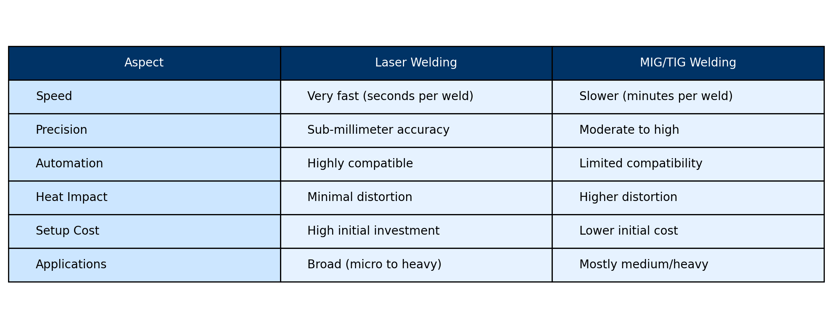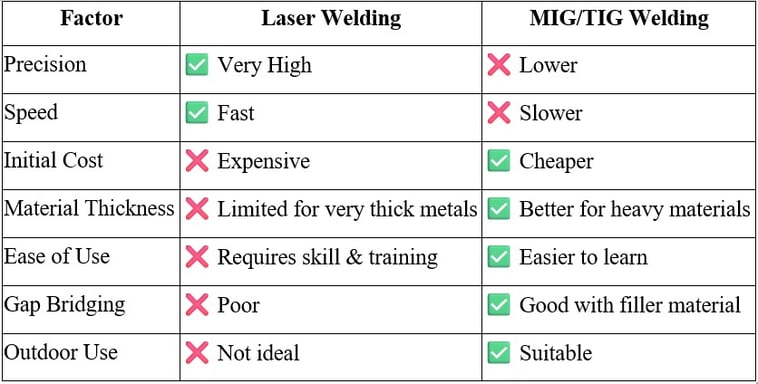Laser Welding Advantages
Discover the benefits of our advanced laser welding technology for precision and efficiency in your projects.
Introduction to Laser
Welding
Laser welding is an advanced fusion welding process that uses a high-energy laser beam to join metals or thermoplastics. It offers precision, speed, and minimal heat input, making it ideal for industries that demand high-quality welds. Laser welding is widely used in automotive, aerospace, medical, and electronics manufacturing due to its ability to create strong, clean welds with minimal distortion.
There are several trade name of laser welding
• Laser welding
• Laser welding machine
• Industrial laser welding
• Laser welding process
• Fiber laser welding


Advantages of Laser Welding
Discover the advantages of our advanced laser welding technology
for your manufacturing needs.
2. Minimal Heat Affected Zone (HAZ)
• Unlike traditional welding methods, laser welding produces minimal heat, reducing distortion and preserving material properties.
1. High Precision & Accuracy
• Laser welding provides pinpoint accuracy, making it suitable for intricate and delicate components..
3. Faster Welding Speed
• Laser welding is significantly faster than MIG and TIG welding, improving production efficiency on thin material.
4. Deep Weld Penetration
• The high energy density allows deep penetration in a single pass within the machine capacity thickness, reducing the need for multiple layers.
5. Non-Contact Process
• The laser does not physically touch the material, reducing tool wear and maintenance costs.
• Laser welding is easily integrated with CNC and robotic systems for high-volume production.
6. Automated & Robotic Integration
7. Ability to Weld Dissimilar Materials
• It can join materials with different melting points and properties, offering more flexibility in manufacturing.
• The high precision of laser welding reduces the need for grinding, polishing, or finishing work.
8. Minimal Post-Weld Processing
9. Better Aesthetic & Strength
• Produces clean, high-strength welds with minimal spatter, ideal for visible or critical applications.
10. Environmentally Friendly
• Generates less waste, consumes less energy, and eliminates the need for filler materials in many cases.


Who Should Own a Laser Welding Machine?
Laser welding is ideal for:
• Manufacturers in Automotive, Aerospace, and Medical Industries
• Job Shops & Custom Fabrication Businesses
• Sheet Metal Industries
• Electronics & Battery Manufacturers
• Jewelry Makers & Watch Repair Specialists
• Industrial Robotics & Automation Companies
• Metal Additive Manufacturing & 3D Printing Firms
• General thin material welding
• Small Businesses: With affordable handheld laser welders now available, even SMEs can adopt this tech.


How to Choose the Right Laser Welding System✅
1. Identify Your Welding Application
Consider the type of work you need the laser welder for:
• Industrial Manufacturing (Automotive, Aerospace, Medical) → High-power fiber laser welding
• Jewelry & Electronics → Precision laser spot welding
• General Fabrication & Repairs → Handheld laser welding • Battery & Micro-welding → Pulsed laser welding
2. Select the Right Laser Type
3. Consider Power Output & Penetration Depth
• Low Power (100W - 500W) → Best for precision applications (jewelry, medical devices).
• Medium Power (500W - 2kW) → Good for general manufacturing and fabrication.
• High Power (2kW - 6kW) → Required for thick metals and industrial automation.
4. Choose Between Handheld vs. Automated Systems
• Handheld Laser Welding Machines
• Best for job shops, repairs, and flexible welding tasks.
• Ideal for small businesses or workshops.
• Automated Laser Welding Systems
• Suitable for mass production and precision applications.
• Integrates with CNC and robotic arms for efficiency.
5. Check Material Compatibility
Different materials require different laser settings:
6. Evaluate Cooling and Maintenance Requirements
• Air-cooled systems → Suitable for low-power applications.
• Water-cooled systems → Required for high-power lasers (better heat management).
Tip: Choose a low-maintenance fiber laser for industrial use to reduce downtime.
Choosing the right laser welding system depends on several factors, including material type, thickness, production volume, and automation requirements. Below is a step-by-step guide to help you select the best system for your needs.
7. Consider Beam Delivery and Spot Size
• Small spot size (0.1mm - 0.5mm) → High precision for micro-welding.
• Larger spot size (1mm - 3mm) → Better for deep penetration and large welds.
8. Software & Control Features
• CNC & Robotic Integration → Ideal for automated production lines.
• Adjustable Pulse Duration & Frequency → Provides better control over weld quality.
• Real-time Monitoring & Sensors → Ensures quality control and consistency.
9. Safety & Compliance
• Ensure the system meets industry standards (ISO, CE, FDA for medical applications).
• Use protective gear (laser safety glasses, enclosures).
• Check for proper ventilation if working with hazardous materials.
10. Budget & ROI Considerations
Laser welding systems range from $5,000 to $500,000, depending on: • Power & Features (Handheld vs. Industrial)
• Automation Level
• Customization & Software Integration ROI
Tip: A laser welding system pays off in high productivity, lower material waste, and reduced post-processing costs.


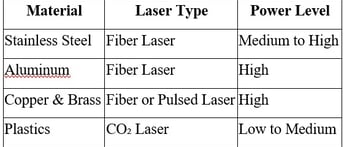

How Laser Welding Improves Productivity
1. High Welding Speeds
Laser welding uses a concentrated beam of light to melt and fuse materials rapidly. Unlike traditional methods like MIG or TIG, which require slower manual or semi-automated processes, laser welding can complete welds in a fraction of the time. For example, in automotive manufacturing, laser welding can join metal sheets at speeds up to 10 meters per minute or more, depending on the material and setup. o Impact: Faster weld times mean more parts processed per hour, directly boosting output.
2. Reduced Setup and Downtime
The non-contact nature of laser welding eliminates the need for frequent tool changes or electrode replacements, common in MIG (wire electrodes) or TIG (tungsten electrodes). Modern fiber laser systems also require minimal maintenance compared to older CO2 lasers.
Impact: Less downtime for adjustments or repairs keeps production lines running smoothly and consistently.
3. Automation Integration
Laser welding systems are highly compatible with robotic arms and CNC machines. Automated setups can operate 24/7 with pre-programmed patterns, reducing reliance on skilled labor and enabling continuous production.
Impact: Automation minimizes human error, ensures repeatability, and allows for higher throughput, especially in high-volume industries like electronics or automotive assembly.
4. Minimal Post-Processing
Laser welding systems are highly compatible with robotic arms and CNC machines. Automated setups can operate 24/7 with pre-programmed patterns, reducing reliance on skilled labor and enabling continuous production.
Impact: Automation minimizes human error, ensures repeatability, and allows for higher throughput, especially in high-volume industries like electronics or automotive assembly.








5. Smaller Heat-Affected Zone (HAZ)
Laser welding delivers energy precisely where it’s needed, minimizing heat spread to surrounding areas. This reduces warping or damage to components, which can otherwise lead to rework or scrap.
Impact: Higher first-pass quality lowers rejection rates and rework time, keeping production on schedule.
6. Versatility Across Materials and Thicknesses
Laser welding can handle a wide range of materials (e.g., steel, aluminum, titanium, plastics) and thicknesses in a single setup, often without needing major reconfigurations. Advanced systems like hybrid laser welding (combining laser with MIG) further expand its capabilities.
Impact: Flexibility reduces the need to switch between different welding processes or machines, streamlining workflows and maintaining production momentum.
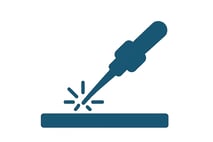

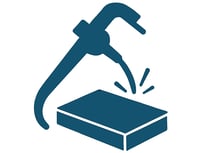

7. Energy Efficiency in Modern Systems
Newer fiber laser welders consume less power than traditional welding machines or older laser technologies, lowering operational costs. They also start up quickly, avoiding long warm-up periods.
Impact: Lower energy use and faster readiness translate to cost savings and more uptime, indirectly supporting higher productivity.


8. Scalability for Small and Large Runs
For small-batch production (e.g., jewelry or medical devices), handheld laser welders offer quick, precise welds without complex setups. For large-scale manufacturing, automated laser systems handle high volumes efficiently.
Impact: Businesses can adapt laser welding to their specific needs, optimizing productivity whether they’re producing 10 units or 10,000.


Laser Welding vs. MIG and TIG Welding: A Detailed Comparison
Laser welding, MIG (Metal Inert Gas) welding, and TIG (Tungsten Inert Gas) welding are three common welding processes, each with its own advantages and ideal applications. Below is a comprehensive comparison of how laser welding stacks up against MIG and TIG welding.
1. Precision and Accuracy
• Laser Welding: Offers the highest precision due to the fine laser beam. It is ideal for intricate components, small welds, and high-precision industries like medical devices and aerospace.
• MIG Welding: Less precise compared to laser and TIG welding. It is typically used for heavy-duty applications where precision is less critical.
• TIG Welding: More precise than MIG welding but requires skilled operators. Used for high-quality welds with good aesthetics.
Winner: Laser Welding (best for high-precision work)
2. Heat Input and Material Distortion
• Laser Welding: Generates minimal heat, reducing distortion and making it suitable for thin materials and heat-sensitive applications.
• MIG Welding: High heat input leads to more warping and distortion, especially on thin metals.
• TIG Welding: Medium heat input, but the manual process can control distortion better than MIG.
Winner: Laser Welding (minimal heat-affected zone)
3. Welding Speed
• Laser Welding: Extremely fast due to its automated and high-energy process.
• MIG Welding: Faster than TIG welding but slower than laser welding.
• TIG Welding: The slowest process due to the need for precise control.
Winner: Laser Welding (fastest process)
4. Material Thickness Compatibility
• Laser Welding: Best for thin materials but can also achieve deep penetration in thicker metals with high-power lasers.
• MIG Welding: Suitable for thicker materials but struggles with very thin sheets.
• TIG Welding: Best for thin materials but slower for thicker applications.
Winner: MIG Welding for Thick Materials, Laser & TIG for Thin Materials
5. Automation & Ease of Use
• Laser Welding: Easily automated with robotics and CNC systems, reducing the need for skilled welders.
• MIG Welding: Can be semi-automated, but manual operation is common.
• TIG Welding: Requires a high level of skill and is mostly a manual process.
Winner: Laser Welding (best for automation)
6. Strength and Aesthetic Quality of Welds
• Laser Welding: Produces strong, clean, and nearly invisible welds with little post-processing required.
• MIG Welding: Strong welds but often requires grinding and finishing due to spatter and rough edges.
• TIG Welding: Produces high-quality, smooth welds with excellent appearance.
Winner: TIG & Laser Welding (both produce clean welds, but laser is faster)
7. Use of Filler Material
• Laser Welding: Often does not require filler material, making it more efficient and cost-effective.
• MIG Welding: Requires filler wire for most welds.
• TIG Welding: Uses filler rods but can also perform autogenous (filler-free) welds.
Winner: Laser Welding (reduces material costs)
8. Application Suitability
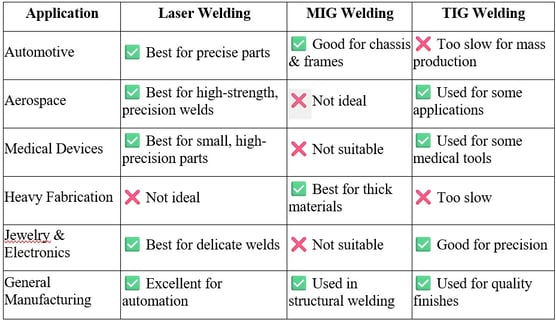

Disadvantages of Laser Welding
While laser welding offers many benefits, it also has some limitations that should be considered before investing in the technology. Below are the key disadvantages:
1. High Initial Cost
• Laser welding machines are expensive, with costs ranging from $5,000 to over $500,000, depending on power and automation level.
• Additional costs for installation, training, and safety measures.
Impact: Not ideal for small businesses or low-volume production without a clear return on investment (ROI).
2. Requires Skilled Operators
• Though automated, laser welding requires trained personnel to operate and maintain the machine.
• Incorrect settings (e.g., power, focus, and speed) can lead to poor weld quality or material damage.
Impact: Increased training costs and potential production errors if not properly managed.
3. Limited Gap Bridging Ability
• Laser welding requires tight part fit-up since the laser beam is narrow and does not naturally fill gaps.
• Unlike MIG and TIG welding, it often does not use filler material, making it unsuitable for poorly aligned joints.
Solution: Precision fixturing and machining are required before welding.
4. Not Ideal for Thick Materials
• While high-power lasers can weld thick materials, MIG and TIG welding are often more cost-effective for heavy fabrication.
• Deep penetration laser welding is energy-intensive and requires advanced setups.
Impact: Industries like shipbuilding and heavy structural welding may find MIG or TIG more practical.
5. Sensitivity to Reflective Materials
• Highly reflective metals (e.g., aluminum, copper, brass) can reflect laser energy, reducing efficiency and causing potential damage to optics.
• Special coatings or higher laser power are needed to improve absorption.
Solution: Use fiber lasers or pulse settings for better absorption in reflective metals.
6. Expensive Maintenance & Repairs
• Laser optics, lenses, and protective windows need regular cleaning and replacement.
• Cooling systems (water-cooled models) require upkeep to prevent overheating.
• Repairs can be costly, especially for high-powered systems.
Impact: Higher long-term maintenance costs compared to traditional welding machines.
7. Safety Risks (Laser Radiation Exposure)
• High-power lasers can cause eye and skin injuries if proper protection is not used.
• Requires safety enclosures, protective glasses, and proper ventilation to prevent exposure and harmful fume buildup.
Solution: Compliance with laser safety regulations (ANSI Z136, ISO 11553) and using class 1 laser enclosures.
8. Limited Outdoor Use
• Laser welding is best for controlled indoor environments.
• Environmental factors like dust, vibrations, and humidity can affect laser performance.
• MIG and TIG welding are better suited for outdoor and construction applications.
Impact: Not ideal for field welding, pipeline repairs, or outdoor structures.
Contact us Now
© 2025. All rights reserved.
VINXUS MARK SDN. BHD.
Registration No. 202501007898 (1609312H)
Office:
17-1, Jalan Sentosa Villa 1/1, Taman Sentosa Villa,4300,Kajang,Selangor
Factory & Warehouse:
N-Tatt Building, No.2, Jalan Tp 5, Taman Perindustrian UEP
Subang Jaya,47600 Subang Jaya, Selagor
Lot 9124, Jalan Telok Gong, Kg Perajurit, 42000,
Pelabuhan Klang, Selangor
Lot 40, Jalan P10/16, Tmn Ind Selaman,43560,
Bandar Baru Bangi, Selangor


No Contact:
+6010-382 2260
sales@laserweldingmalaysia.com

